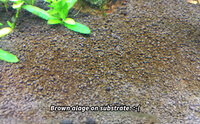Hi everyone
I have this brown stuff growing on my plants and substrate for the past 1 week.
Also I notice this stuff can be wiped away easily from the plants.
Can someone confirm if this is indeed diatoms and why I'm getting it after 1 year of having this tank?
How do you treat this?
Just for your info: I did a major plant replanting on one half of the tank and intend to do one more this week.
Thank you and Cheers.




I have this brown stuff growing on my plants and substrate for the past 1 week.
Also I notice this stuff can be wiped away easily from the plants.
Can someone confirm if this is indeed diatoms and why I'm getting it after 1 year of having this tank?
How do you treat this?
Just for your info: I did a major plant replanting on one half of the tank and intend to do one more this week.
Thank you and Cheers.







 cheer up.
cheer up.